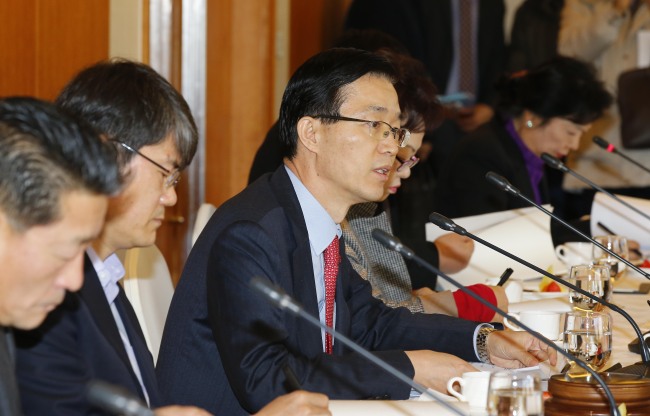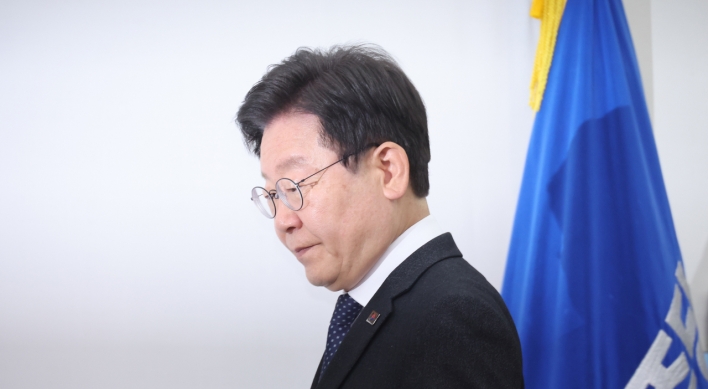South Korea’s traditional herbal medicine -- currently sold in packs of prepared herbs or decocted herbs in drinkable pouches -- will be made into tablets and syrup as part of the government’s efforts to standardize their quality, the Health Ministry announced Wednesday.
The announcement came just a day after the biggest group of traditional doctors announced that they would file a lawsuit against the ministry if the government does not guarantee their right to use nontraditional medical equipment, such as ultrasound, by the end of January.
The announcement came just a day after the biggest group of traditional doctors announced that they would file a lawsuit against the ministry if the government does not guarantee their right to use nontraditional medical equipment, such as ultrasound, by the end of January.

The ministry made it clear that the latest proposal does not include any plans to let the doctors use medical devices.
Some of the major proposals include publishing standardized guidelines for traditional doctors to use for a total of 30 most common health conditions among patients who choose to visit traditional clinics. They include: indigestion, obesity, depression, insomnia, infertility, dementia, cancer, failed back surgery syndrome and spinal stenosis.
For the publication of the guidelines, the Health Ministry will launch a three-year clinical research for each of the 30 conditions. All university textbooks used for traditional medicine programs will be standardized as well.
“We’ve been hearing a lot of comments from patients who said they have difficulty finding a good traditional clinic,” said Ko Deuk-Yung, director general of Traditional Medicine bureau of the Health Ministry.
“We want to standardize the services and medicines so patients can be guaranteed quality treatment as long as they visit the clinics that have been approved by the government.”
According to a 2011 government survey, 34 percent of Koreans who have been treated at traditional clinics said they were dissatisfied with the services because each clinic had different treatment methods for their conditions.
Ko said while the government acknowledges that there are many advantages of “cheopyak,” a package of prepared medicinal herbs, it is hard to standardize the quality as clinics use different herbs for different conditions. Once made into tablets and syrup, it will be easier for the government to scientifically review their quality and safety, the director general said.
“Tablets are also more accepted by the general public,” Ko added.
The Association of Korean Medicine, the largest body of traditional doctors in country, however, said it’s questionable if standardization would be possible if they are not allowed to use nontraditional medical scanning equipment, such as ultrasound or X-ray machines, for more accurate diagnosis.
Currently, the Korean law allows traditional medical professionals to use all nontraditional medical scanning equipment except for MRI and CT scanners.
According to the latest government data, the medical bills of Koreans on traditional medical treatment increased from 2010-2014. Overall expenditure on traditional medical treatment, such as acupuncture, in 2014 was 2.4 trillion won ($2.2 billion). The spending has increased significantly since 2010, with an average annual growth rate of 7.7 percent per year, according to the state-run Health Insurance Review and Assessment Service.
One of the biggest factors behind this growth is the country’s growing elderly population, many of whom prefer traditional treatments over Western medicine, according to the government.
The Health Ministry said it plans to come up with a system where the cost of herbal medicine for the 30 health conditions can be covered by the National Health Insurance. Currently, most of herbal medicines are not covered by the NHI, except herbs that have been powdered. .
In 2014, payments for traditional medical treatments and herbal medicine only accounted for 4.17 percent of all national insurance payments that year.
The ministry is also coming up with a system where patients can be treated by both physicians and traditional doctors at the same time, especially at state-run medical facilities such as the National Medical Center.
There have been a number of cases where the condition of those who suffered spinal cord injuries improved significantly after receiving both Western and Korean traditional treatments at the National Rehabilitation Center, said Kim Dae-wook, the director of division of Traditional Korean Medicine Policy at the Health Ministry.
The government’s latest measure that sidestepped the contentious issue of medical equipment is likely to further stoke debate.
A number of traditional doctors have faced lawsuits filed by doctors who practice Western medicine, who claimed it is dangerous for those who are not trained in medical science to use any conventional medical equipment.
A number of cases have been won by nontraditional doctors in the past -- which eventually prohibited traditional doctors from using certain devices.
As a part of its deregulation agenda, the Office of Government Policy Coordination and the Health Ministry together announced in January last year that they were considering a law that lets traditional doctors use nontraditional medical devices without having to worry about being sued by regular physicians.
The ministry had promised to come up with the system by the end of 2015, but it never happened as there was fierce opposition from the Korean Medical Association, which represents 100,000 physicians.
“We think it’s a great plan,” Kim Ji-ho from the Association of Korean Medicine told The Korea Herald. “But considering the way the Health Ministry has been treating us in the past year, we are not sure if any of this plan is going to actually materialize.”
Kim said if the Health Ministry does not guarantee traditional doctors’ rights to use medical equipment by the end of January, AKOM would file an administrative litigation against the government. On Tuesday, the group’s representative Kim Pil-geon used a bone density scanner for a patient in front of reporters to show how an equipment can help a traditional doctor make a diagnosis. Right after the press meeting, he was reported to prosecutors by physicians who practice Western medicine.
The KMA also released a statement reaffirming its stance against the traditional doctors’ use of medical equipment. “We are afraid that patients would be asked to take unnecessary medical examinations by those who have not been properly trained to use such equipment to make scientific diagnosis,” the organization said in a statement.
Ko from the Health Ministry said the issue is a “sensitive matter” and it’s very important that the two organizations -- AKOM and KMA -- communicate with each other and make compromises. “We’ll do our best as a mediator,” he said.
By Claire Lee (dyc@heraldcorp.com)





![[Herald Interview] 'Amid aging population, Korea to invite more young professionals from overseas'](http://res.heraldm.com/phpwas/restmb_idxmake.php?idx=644&simg=/content/image/2024/04/24/20240424050844_0.jpg&u=20240424200058)











![[KH Explains] Korean shipbuilding stocks rally: Real growth or bubble?](http://res.heraldm.com/phpwas/restmb_idxmake.php?idx=652&simg=/content/image/2024/04/25/20240425050656_0.jpg&u=)

